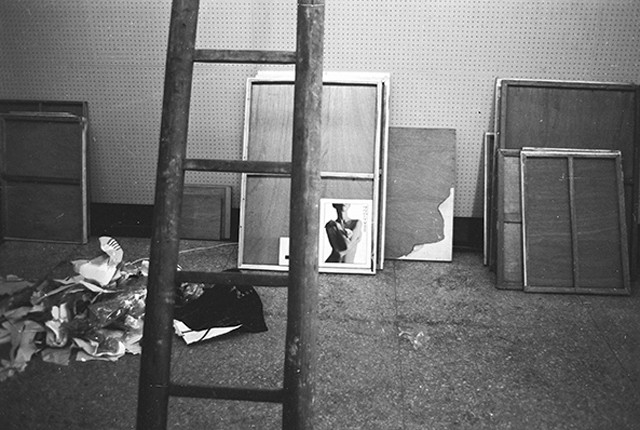MAM Research 001: Great Crescent, Art and Agitation in the 1960s – Japan, South Korea, Taiwan
25 Apr - 05 Jul 2015

Huang Huacheng
Ecole de Great Taipei Autumn Exhibition
Hai Tian Gallery, Taipei, 1966.
Photo and photo courtesy: Chuang Ling
Ecole de Great Taipei Autumn Exhibition
Hai Tian Gallery, Taipei, 1966.
Photo and photo courtesy: Chuang Ling
MAM RESEARCH 001: GREAT CRESCENT, ART AND AGITATION IN THE 1960S – JAPAN, SOUTH KOREA, TAIWAN
25 April - 5 July 2015
Japanese and Asian contemporary art is one of the main focuses of the Mori Art Museum’ s programs, yet “Asia” covers a broad territory, making it difficult to grasp an overall picture of it. The newly launched “MAM Research” program will examine the multilayered social, political and economic backgrounds that have given rise to Asian contemporary art and seek to shed light on their historical contexts, while focusing on individual artists, curators, art movements and art institutions throughout Asia. Premised on collaborative projects with archives, research institutions and scholars around Asia, “MAM Research” will not limit displays to “artworks” but also present such materials as videos, photographs, texts and historical records. Through “MAM Research,” Mori Art Museum aims to serve as a platform for broader discussions.
MAM Research 001: Great Crescent, Art and Agitation in the 1960s - Japan, South Korea, Taiwan
The first exhibition in this series "MAM Research 001: Great Crescent, Art and Agitation in the 1960s - Japan, South Korea, Taiwan" is a reconfiguration of an exhibition held in 2013 at the Hong Kong alternative space "Para Site."
In recent years, there have been moves not only to enrich art history by focusing beyond those countries in the West that led the way in the 20th century but also to trace the multi-tiered development of modernism in countries outside the Western bloc. The title of this exhibition derives from the term used to describe the crescent-shaped region stretching from Japan through Southeast Asia to the Persian Gulf as part of America's post war policy towards Asia. From the Meiji period until the end of WWII, Japan ruled the Korean peninsula and Taiwan. While they started to take different paths on their own in the 1960s, this exhibition is an attempt to verify from a comparative perspective on the anti-establishment and anti-art activities that unfolded as the artists in these regions explored their own avenues of expression, not along the modernism that was introduced from the West.
Participating Artists: Chang Chao-Tang, Choi Boong-hyun, Chuang Ling, Kim Gulim, Hi Red Center, Huang Huacheng,Jeong Gang-ja, Kang Guk-jin, Yoko Ono, Zero Dimension
Floor Intervention: Leung Chi Wo
25 April - 5 July 2015
Japanese and Asian contemporary art is one of the main focuses of the Mori Art Museum’ s programs, yet “Asia” covers a broad territory, making it difficult to grasp an overall picture of it. The newly launched “MAM Research” program will examine the multilayered social, political and economic backgrounds that have given rise to Asian contemporary art and seek to shed light on their historical contexts, while focusing on individual artists, curators, art movements and art institutions throughout Asia. Premised on collaborative projects with archives, research institutions and scholars around Asia, “MAM Research” will not limit displays to “artworks” but also present such materials as videos, photographs, texts and historical records. Through “MAM Research,” Mori Art Museum aims to serve as a platform for broader discussions.
MAM Research 001: Great Crescent, Art and Agitation in the 1960s - Japan, South Korea, Taiwan
The first exhibition in this series "MAM Research 001: Great Crescent, Art and Agitation in the 1960s - Japan, South Korea, Taiwan" is a reconfiguration of an exhibition held in 2013 at the Hong Kong alternative space "Para Site."
In recent years, there have been moves not only to enrich art history by focusing beyond those countries in the West that led the way in the 20th century but also to trace the multi-tiered development of modernism in countries outside the Western bloc. The title of this exhibition derives from the term used to describe the crescent-shaped region stretching from Japan through Southeast Asia to the Persian Gulf as part of America's post war policy towards Asia. From the Meiji period until the end of WWII, Japan ruled the Korean peninsula and Taiwan. While they started to take different paths on their own in the 1960s, this exhibition is an attempt to verify from a comparative perspective on the anti-establishment and anti-art activities that unfolded as the artists in these regions explored their own avenues of expression, not along the modernism that was introduced from the West.
Participating Artists: Chang Chao-Tang, Choi Boong-hyun, Chuang Ling, Kim Gulim, Hi Red Center, Huang Huacheng,Jeong Gang-ja, Kang Guk-jin, Yoko Ono, Zero Dimension
Floor Intervention: Leung Chi Wo
